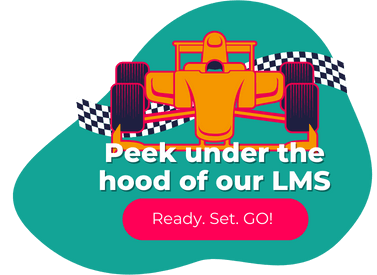Whether you’re on the hunt for a learning management system (LMS) that’s internally focused for training or externally focused for driving leads, you should look for these seven, must-have features.
- User Experience
- Mobile Learning
- Course Management
- Quizzes and Assessments
- User and Data Storage
- Course Feedback Surveys
- Tool Integration
Throughout this article, you will see how several learning management systems deploy the following features, including HubLMS, which is built within your HubSpot platform.
1. User Experience
The first thing you need to focus on when choosing an LMS to create a course for your team, leads or customers is user experience.
This means one of the major functionalities of any great learning management system is the ability to layout and design your educational content in a way that is pleasing to the user and the builder.
Think:
- Course overview layouts
- Lesson organization and hierarchy
- Learner flows from lesson to lesson
- Interactive elements and in-lesson engagement
- Learner portals and dashboards
- Feedback collection
- and so much more.
Pro-Tip: before you buy, ask for an example or two of the LMS you are evaluating in action to see how the final product looks and feels for your learners and get a peek of the back-end to see how it looks and feels for your admins.
WordPress LMS Options & UX
WordPress-based learning management systems are extremely popular because of the way they’ve been built geared toward user experience. They have been forced to be created in a way that works with the WordPress system. As well as many systems like Elementor, Beaver Builder, and Divi have extra functionality either for or that works in tandem with LMS plugins.
Depending on how your WordPress website is configured, or your level of proficiency with your WordPress tools, this may have varying freedom for marketers, educators, and other LMS admins in your account.
So if you take a system like LearnDash, MemberPress, or even LifterLMS, you should be able to design something that looks good and is easy to use.
| MemberPress |
Here’s what LifterLMS has to say about themselves. The “All-In-One” Membership Plugin for WordPress. MemberPress will help you build astounding WordPress membership sites, accept credit cards securely, sell online courses, control who sees your content and sell digital downloads... all without the difficult setup. |
| LifterLMS | Here’s what LifterLMS has to say about themselves. The Most Flexible WordPress LMS for Your Online Learning Website. Save money and increase learner success from your customizable course or membership website that you own and control. All-in-one affordable LMS system to start, run, and grow your business. |
| LearnDash | Here’s what LearnDash has to say about themselves. Don’t just sell courses, sell more courses. With LearnDash you have complete control when selling your online courses. Choose the pricing model, up-sell offerings, reminder notifications, and watch your sales soar! |
HubSpot LMS + UX
Whereas the WordPress plugin LMS builders you might typically choose pair with a WordPress page builder, the HubLMS learning management system isn’t a new tool or added app.
Rather, when you buy HubLMS, you are installing is few custom configurations of modules and properties added to your HubSpot CMS and CRM.
Using the HubLMS Course Builder module — and a few other bonus modules — you have the full power of HubSpot’s CMS at your fingertips to build your learning content.
Whether you are completely new to building website pages, or a seasoned veteran of HubSpot page builders, you can create a course that dazzles learners in a matter of minutes in the HubSpot website and landing page tools.
Providing a great experience for your instructors and admins means you are removing friction from creating even better experiences for your learners.
A few of the best features for an amazing admin experience in building courses:
- Universal design settings (or “theme settings”) for set it and forget it branding
- Drag & drop layout builder and editor for adding, moving and removing text boxes, images, buttons, and more
- Desktop and mobile editors on the same page to view and optimize for different student devices
- Universal File Manager for sharing icons, graphics, stock photography, and videos between all of your HubSpot users
- Intuitive and easy-to-setup A/B testing
Plus it’s connected to your HubSpot CRM for learner and page tracking that is connected and seamless. Say goodbye to having a separate system to track how people and companies engage with your courses, website pages, emails, and all other pieces you use HubSpot for.
2. Mobile Learning
If your LMS does not allow for mobile learning management system functionality, then put down your pencil and slowly walk away. Did you know Americans spent eight percent more time on mobile than watching live TV each day?
Make amazing mobile learning experiences, so that your users can go right from email or social media or Hulu or Netflix to your course material without skipping a beat.
LMS platforms that are not accessible on other devices like tablets and phones, are not capturing the bandwidth of their online learning program.
Frankly, that's just lame.
If your LMS is not mobile-friendly, you’re missing out on the ability to reach your learners on their favorite mobile devices and catch them on the go.
3. Course Management
This one is pretty huge and something most folks think about in hindsight. Most times when you get started with an LMS, it’s because you are creating your first course, not your 15th.
But, what happens when you try to create 4, 7, or 15 courses for your user experience? And what is your experience like managing them on the backend?
You should be able to easily create a course page that shows all available courses. You should also be able to restrict access to courses based on what the user has purchased or has permission to use.
How easy is it or do you need a degree in coding to understand how to set up individual courses? Are you locked into a system that makes you choose a bronze, silver, gold level course mentality?
You need to be able to create and manage courses, categorize them, enroll users, and pull reports quickly and easily so you don’t spend unnecessary time on tasks that could be more automated.
Speaking of automation, does your LMS have that? More on that in a bit.
4. Quizzes and Assessments
If your learner takes the time to read all of your material, or better yet watch all of your videos, how do you know they actually retained the material?
Simply put, you don’t, unless you are able to provide a quiz or assessment in your LMS.
When it comes to quizzes, you want something that allows you to easily set up your questions and its possible answers.
On the other side of quizzes, you want something that keeps track of the right and wrong answers and provides you and the learner a score for that quiz.
And, in a perfect world, if they pass the quiz, you want to email or display a certification (or even a downloadable PDF version) they can print out and hang on their wall with pride.
5. User and Course Data Storage
Speaking of quiz scores, where are you going to store that information? Or, where are you going to store the learner's information like profile and courses purchased?
If it is built in WordPress, you may or may not have this option out-of-the-box. If you do, you will need to do a bit of manual set up to make sure this data is added to your master system of record to see a bigger picture of learner and course engagement.
Most conversations around data for LMS systems turn into a Salesforce or some type of customer relationship management (CRM) integration. Translation: you need to connect to another piece of software, which involves additional cost and complexity to your internal system.
Why not choose an LMS built on a CRM??
That’s why we prefer HubSpot. With HubSpot’s connect CRM and website page tools, you’re able to track how a specific website page or course is doing and how specific users are doing in your courses.
Plus that data is already tracked in the same system as your other marketing, sales and service data (like email engagement, open opportunities, and support tickets).
No matter what learning management system you choose, you have to make sure you are thinking about where you will store all of the data you will be collecting and if it is secure.
Learn more about HubSpot’s security details.
6. Course Feedback Surveys
Unless you get feedback from your users post-learning, you will never know if those who sign up for the courses you provide actually like the material and found it valuable.
Feedback is the breakfast of champions and so, your LMS should give you an easy way to get that feedback from your users. That way, you can add more content, tweak your communication style, and really dig in and make your course material top-notch over time.
7. Tool Integration
Where are you hosting your videos to keep page speed fast?
Make sure your LMS choice allows you to integrate with your video hosting company. Our choice is Wistia, but yours could be Vimeo or even Youtube. Your LMS needs to work no matter where you host your video content.
Want to use other multimedia outside of videos in some of your courses or lessons? Make sure that option is available too!
How are you staying in touch with your learners?
Depending on the LMS you choose to build out your content, you may need an additional tool to automate:
- Sending email reminders and announcements
- Sending Slack messages to student groups and cohorts
- Creating tasks for your sales team to follow up
If you choose a tool build in HubSpot, these things are already built in! (See why we love HubSpot so much?)
What about your payment processor?
If you are only creating free courses for lead generation, then you can probably skip this and not worry about it. However, if you are creating courses to generate more revenue for your business, make sure your LMS integrates with a payment gateway like PayPal or Stripe.
More Important LMS Functionality
To be honest, a post on 7 LMS features you need to have doesn’t even begin to scratch the surface. There are so many other pieces of functionality you should pay attention to.
Features and functions like reporting, automation, communications, SEO, social promotion, and an entire content strategy around your courses could launch a thousand blogs.
The great thing is that when you use HubLMS, all of those features come standard in the HubSpot CRM & HubSpot CMS so, you have nothing to worry about.

To understand how powerful the HubLMS LMS may be for you, you first need to understand how powerful HubSpot could be for your entire business.
Continue your LMS journey and learn more about how HubSpot can be the foundation of your Learning Management System and the power-up your marketing and sales machine needs moving forward.




.png?length=600&name=Blog%20Images%20(2).png)